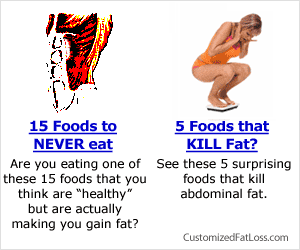Seven Day Diet
If you are in need of an 7 day diet plan to get you losing weight, here is a simple one to follow.
Breakfast Is Important
Start off by making a large, healthy meal every morning to get your metabolism running. The food you consume in the morning is used as your bodies fuel to get you through til lunch time. Skipping breakfast is not recommended for anyone who plans to lose weight.
Stopping off to grab something to eat later in the morning is tempting if you haven’t eaten breakfast, and you tend to eat more than you would have to begin with. Most of the time, the food chosen is an unhealthy one. It is easier to eat breakfast to let your brain know that you do not need another meal too soon, and this will let you forget worrying about extra calories.
Consume More But Smaller Amounts
The seven day diet has the goal of shedding excess calories but having enough nutrients to keep your body healthy. When you consume less calories, your body continues to burn the same amount of fat you did to start with, which lets you lose weight quickly.
Fitting more smaller meals in each day can help to lose weight effectively. Your body is able to cope with the digestion of bigger meals more easily this way. This will be the reason behind most feelings of tiredness and lack of energy.
Top Up With Fibre
How to lose weight in 7 days: Losing pounds quickly requires a diet change. Eating more fibre in the way of veges, fruit and whole grain is a great way to do this. Fibre fills you up with less chance of feeling hungry in the short-term.
More Water
It is imperitive to listen to your body when changing diets to ensure you are not adding any extra pressure than necessary. You can replace soda drinks with water to help this. Water flushes the body of toxins and keeps you hydrated. It not only refreshes you but has no calories either.
Emily Dawson is an avid effective weight loss programs promoter. Emily writes articles primarily on how to lose weight in 7 days and how to become skinny fast.
More Diet Articles
The Seven Dimensions of Wellness
What is “wellness” per se? There are many definitions, and 20 years ago, wellness didn’t exist. But today, the industry is growing fast, and the term “wellness” is being overused, abused and it is not being used in its appropriate context. Wellness is achieving one’s full potential; it is self-directed and an ever-evolving process. Wellness has seven dimensions: occupational, spiritual, intellectual, emotional, environmental and physical. When all of these dimensions are met, then we are considered whole or complete. Wellness is more than just products to make us feel good or be physically fit.
Here is what each of the seven dimensions mean:
1. Social Wellness. This is how a person contributes to their environment and community and how he or she builds better living spaces and social networks. The social dimension encourages contributing to one’s environment and community.
2. Occupational Wellness. Occupational development is related to one’s attitude about one’s work, and recognizes personal satisfaction and enrichment in one’s life through work. The choice of profession, job satisfaction, career ambitions and personal performance are all important components of this dimension. To be occupationally well, a person is ultimately doing exactly with what they want to do in life and are comfortable with their future plans.
3. Spiritual Wellness. The spiritual dimension recognizes our search for meaning and purpose in human existence. It does not mean one is religious, but that it is better to ponder the meaning of life and be tolerant of the beliefs of others than to close our minds and become intolerant. Spiritually well people take time out of their day for spiritual growth and learning. They have a clear sense of right and wrong, and they act accordingly.
4. Intellectual Wellness. This dimension recognizes one’s creative and stimulating mental activities as well as expands knowledge and skills while sharing his or her gifts with others. The intellectually well person is open to new ideas, thinks critically and seeks out new challenges. These people will stretch and challenge their minds with intellectual and creative pursuits instead of becoming self-satisfied and unproductive.
5. Emotional Wellness: Emotional Wellness. This dimension includes the capacity to manage one’s feelings and related behaviors, including the realistic assessment of one’s limitations, development of autonomy and the ability to cope effectively with stress. Emotionally well people have the ability to express feelings freely and manage feelings effectively. They are also aware of and accept a wide range of feelings in themselves and others.
6. Environmental Wellness. This includes the ability to promote health measures that improve the standard of living and quality of life in the community, including laws and agencies that safeguard the physical environment. The environmentally well person is aware of the earth’s natural resources, conserves energy, buys organic foods and products, and enjoys and appreciates spending time in natural settings.
7. Physical Wellness. This is what we all do well in our health clubs. It is met through the combination of good exercise and eating habits, taking precautions for self-care and receiving appropriate health screenings throughout our lives. It also means taking personal responsibility and care for minor illnesses and knowing when professional medical attention is needed. Physically well people understand and appreciate the relationship between sound nutrition and how their body performs. The physical benefits of looking good and feeling terrific most often lead to the psychological benefits of enhanced self-esteem, self-control, determination and a sense of direction. Integrating Wellness into Your Facility
What are you doing in your programming to promote wellness? First, you have to decide what will wellness mean in your facility. Does your facility have spa amenities, dietitians, offer corporate wellness programs, physical therapists/chiropractors or a recycling program? Wellness is more than just going to the gym to work out these days. It means getting a sports massage, attending a health seminar or seeking the expertise of a registered dietitian. It is helping the member to relieve stress and educate health through other means besides physical fitness.
It is predicted that the wellness industry will be the next trillion-dollar industry, and in the next 10 years, an additional $ 1 trillion dollars of the U.S economy will be focused on getting Americans healthy through programming and treating the whole person.
Americans are already spending more than $ 200 billion in the industry, including $ 150 billion per year in the nutrition industry (of which $ 19.8 billion are on supplements) and $ 24 billion for fitness clubs. The need for personal, customized care is growing because people are willing to spend the money to safeguard their youth and be well. It is time to shift our focus, get creative and develop wellness-based programs for our members.
Jasmine Jafferali, MPH, is the Program Coordinator and an instructor for Educational Fitness Solutions, Inc., Professional Certificate in Women’s Personal Exercise Training and Wellness. She has a diverse fitness background with over ten years of industry experience in campus recreation, corporate wellness, and the commercial health club setting. To learn more about her program, visit: http://www.efslibrary.net
Related Wellness Articles
Categories: Wellness Tags: Dimensions, Seven, Wellness






-SMALL.gif)
